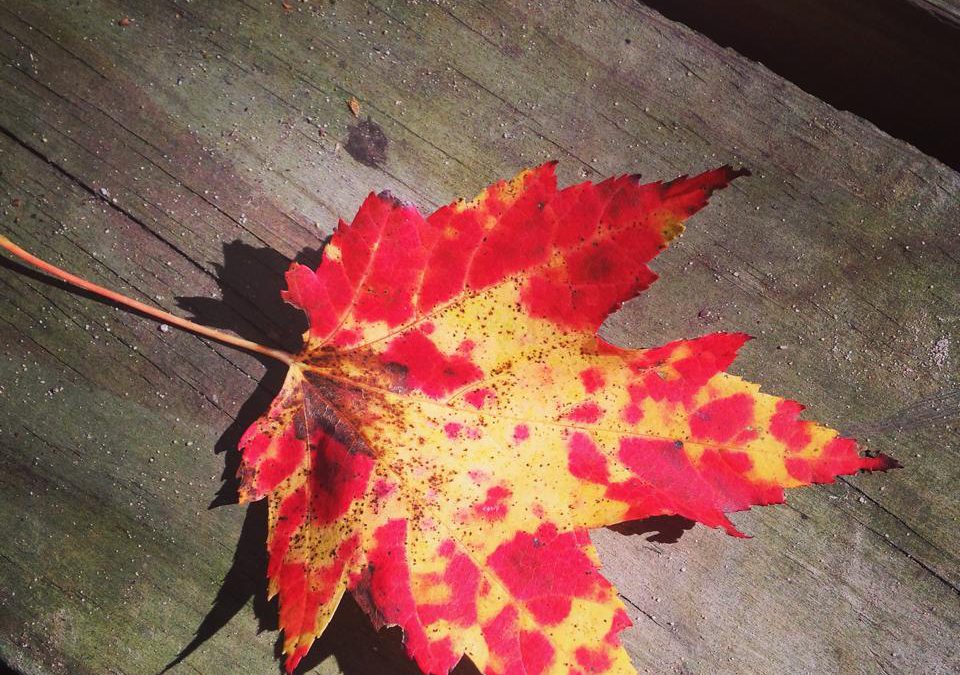
by Carrie Stevenson | Nov 18, 2020
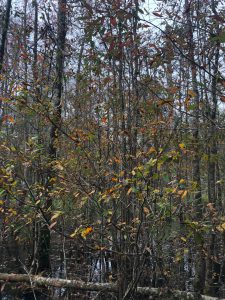
A blackgum/tupelo tree begins changing colors in early fall. Photo credit: Carrie Stevenson, UF IFAS Extension
It’s autumn and images of red, brown, and yellow leaves falling on the forest floor near orange pumpkins enter our minds. However, Florida isn’t necessarily known for its vibrant fall foliage, but if you know where to look this time of year, you can find some amazing scenery. In late fall, the river swamps can yield beautiful fall leaf color. The shades are unique to species, too, so if you like learning to identify trees this is one of the best times of the year for it. Many of our riparian (river floodplain) areas are dominated by a handful of tree species that thrive in the moist soil of wetlands. Along freshwater creeks and rivers, these tend to be bald cypress, blackgum/tupelo, and red maple. Sweet bay magnolia (Magnolia virginiana) is also common, but its leaves stay green, with a silver-gray underside visible in the wind.
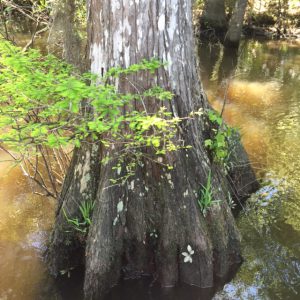
The classic “swamp tree” shape of a cypress tree is due to its buttressed trunk, an adaptation to living in wet soils. Photo credit: Carrie Stevenson, UF IFAS Extension
Bald cypress (Taxodium distichum) is one of the rare conifers that loses its leaves. In the fall, cypress tress will turn a bright rust color, dropping all their needles and leaving a skeletal, upright trunk. Blackgum/tupelo (Nyssa sylvatica) trees have nondescript, almost oval shaped leaves that will turn yellow, orange, red, and even deep purple, then slowly drop to the swamp floor. Blackgums and cypress trees share a characteristic adaptation to living in and near the water—wide, buttressed trunks. This classic “swamp” shape is a way for the trees to stabilize in the mucky, wet soil and moving water. Cypresses have the additional root support of “knees,” structures that grow from the roots and above the water to pull in oxygen and provide even more support.
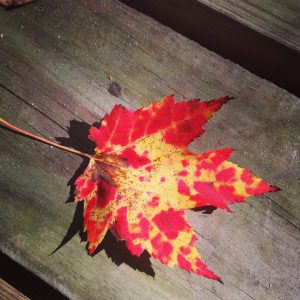
A red maple leaf displaying its incredible fall colors. Photo credit: Carrie Stevenson, UF IFAS Extension
The queen of native Florida fall foliage, however, is the red maple (Acer rubrum) . Recognizable by its palm-shaped leaves and bright red stem in the growing season, its fall color is remarkable. A blazing bright red, sometimes fading to pink, orange, or streaked yellow, these trees can jump out of the landscape from miles away. A common tree throughout the Appalachian mount range, it thrives in the wetter soils of Florida swamps.
To see these colors, there are numerous beautiful hiking, paddling, and camping locations nearby, particularly throughout Blackwater State Forest and the recreation areas of Eglin Air Force Base. But even if you’re not a hiker, the next time you drive across a bridge spanning a local creek or river, look downstream. I guarantee you’ll be able to see these three tree species in all their fall glory.
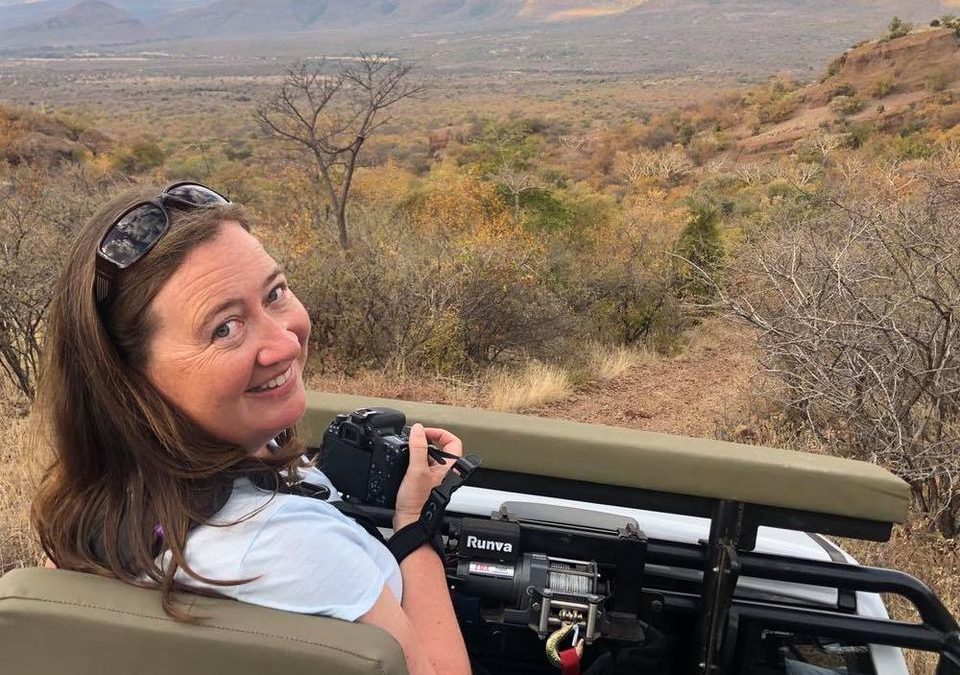
by Carrie Stevenson | Aug 27, 2020
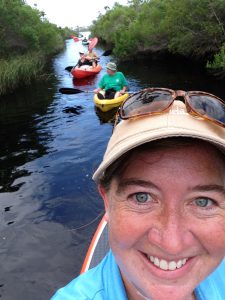 Carrie Stevenson is the Coastal Sustainability Agent for the UF/IFAS Escambia County Extension Office, and has been with the organization almost 17 years. Her educational outreach programs focus on living sustainably within a vulnerable coastal ecosystem. She helps clientele better understand how to protect and preserve local ecosystems and water resources, wisely use our abundant rainfall and sunlight, and prepare and mitigate for flooding, coastal storms and climate impacts.
Carrie Stevenson is the Coastal Sustainability Agent for the UF/IFAS Escambia County Extension Office, and has been with the organization almost 17 years. Her educational outreach programs focus on living sustainably within a vulnerable coastal ecosystem. She helps clientele better understand how to protect and preserve local ecosystems and water resources, wisely use our abundant rainfall and sunlight, and prepare and mitigate for flooding, coastal storms and climate impacts.
Growing up an avid reader and science junkie, a young Carrie aspired to find a career that allowed her to “be outdoors and wear jeans,” and in college sought to become a science writer. When National Geographic didn’t come calling, she found a position as a field-based environmental specialist with the Florida Department of Environmental Protection. There, she handled compliance and enforcement cases related to stormwater and wetlands, spending days tromping through the swamps, wet prairies, and newly built subdivisions of northwest Florida. After joining UF IFAS Extension, she spent 6 years as a Florida Yards & Neighborhoods Agent before switching to Coastal Sustainability. Her expertise and articles focus on climate issues, stormwater, hurricanes, native plants, and wetlands.
A lifelong outdoors enthusiast, she enjoys biking, standup paddleboarding, and traveling to national parks with her family. She also has many favorite international outdoor experiences, ranging from hiking glaciers in Canada to snorkeling coral reefs in Belize and watching elephants drink from a South African river. A native of Mississippi, Carrie has lived with her husband in Pensacola since 1999. Carrie earned her master’s degree in Biology/Coastal Zone Studies from the University of West Florida in Pensacola and an undergraduate degree in Marine Science from Samford University (Birmingham, Alabama). She is the proud mom of an Eagle Scout and leads her daughter’s Girl Scout troop. She is a Fellow in the Natural Resources Leadership Institute (NRLI), past president of the Florida Association of Natural Resource Extension Professionals (FANREP), and member of IMPACT 100 Pensacola Bay.

by Carrie Stevenson | Jul 31, 2020
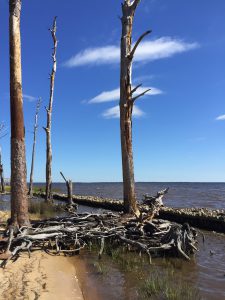
A living shoreline project was implemented on this bay in Santa Rosa County to try and prevent further erosion. Photo credit: Carrie Stevenson, UF IFAS Extension
We have reached that time of year when the Atlantic starts cranking out storms, and they will continue to roll out as the dog days of summer progress. Over the last decade, many experts have speculated on how climate change and sea level rise might impact hurricanes in the Gulf of Mexico. Two big issues are coastal erosion and flooding from storm surge and rainfall.
Those who live on the water or frequently visit area shorelines have probably noticed coastal erosion. While a natural part of a coastal ecosystem–and often exacerbated by heavy boat traffic–rising seas can also cause erosion. Sea level rise moves water slowly inland and washes away the roots of grasses and trees that once held the shoreline in place. Buildings and roads close to the water are impacted as well, with “sunny day flooding” on the roads and under pilings in many south Florida cities where water has moved in to stay. Large scale beach renourishment projects, living shorelines, and even road relocations (like the one at Ft. Pickens on Pensacola Beach) are all ways that local officials and property owners can respond to rising seas. However, these efforts always come with a big price tag. When that “line in the sand” is drawn beyond government and household budgets, there will come a point when we can no longer support protection of highly vulnerable coastal infrastructure. The closer a building is physically located to the water (whether built there intentionally or reached by rising seas), the greater the likelihood a hurricane will cause flooding damage from dangerous storm surge. Storm surge and heavy flooding cause 75% of the deaths in any given hurricane.
During a recent webinar, the appropriately named Dr. Chris Landsea of the National Hurricane Center answered several frequently asked questions on the impacts of global warming on hurricanes. Some of the predictions are surprising based on assumptions that have been put out in the media. He made a disclaimer that these are his predictions based on years of expertise and data analysis, and not an official proclamation by the National Hurricane Center. Following are a few of the points he made during his talk.

Dr. Chris Landsea of the National Hurricane Center recently met with floodplain managers around the Gulf Coast to discuss hurricanes.
Question: Will hurricanes get stronger based on increased temperatures?
Answer: The world average temperature has gone up 1.5 degrees Fahrenheit in the past 100 years. Based on data and computer modeling from the NOAA Geophysics Lab, typical hurricane wind intensity will increase slightly, by 3%. In this example, a storm with 100 mph average winds would be 103 mph by the end of the 21st century.
Question: Will we experience more tropical storms as the climate changes?
Answer: Dr. Landsea does not expect more tropical storms as the temperature increases. In fact, frequency may drop very slightly. While there may be more heat energy for hurricanes to feed on, the surrounding conditions will make it tougher for a storm to form. Those conditions may be atmospheric or include a vertical wind shear that tears up the storm.
Question: How will global warming affect rainfall during hurricanes?
Answer: Models and recent experience show that rainfall will increase by 10-20% during tropical storms. Global warming increases the amount of moisture in the atmosphere, and a hurricane can recycle this water into a constant loop of rainfall. Hurricane Harvey in Texas was one example of this situation, during which nearly 8 feet of rainfall fell, flooding neighborhoods. One of the aphorisms of climate change is “wet places get wetter, and dry places get drier.”
Dr. Landsea’s full presentation can be found online here, if you are interested in learning more. Keep in mind that these predictions can change based on land use, atmospheric carbon levels, and human practice change. For more on the work UF IFAS is doing on climate, visit this Florida Sea Grant Climate page.
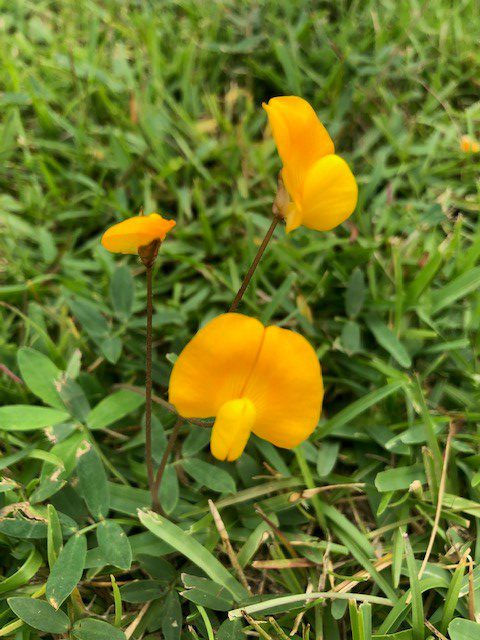
by Carrie Stevenson | Jul 2, 2020
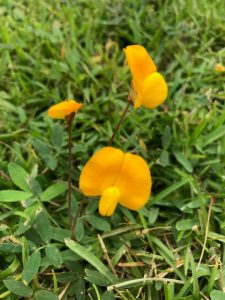
The bright yellow perennial peanut flower is not only pretty, but edible! Photo credit: Carrie Stevenson, UF IFAS Extension
It’s bright yellow, makes its own fertilizer, and tastes like peanut butter. On my morning walks around the track at our office, I have noticed lately that the perennial peanut (Arachis glabrata) is growing lushly, fulfilling its role as a low maintenance groundcover. The plant thrives in hot weather, full sun, and humidity, so we have nearly reached peak growing conditions for this South American native.
Perennial peanut was brought in from Brazil almost 90 years ago as a valuable hay crop and livestock forage. It is still used regularly for these purposes. However, as years of experience have borne out, there are no insect, disease, or unwanted invasive issues with the plant. The lush green groundcover has been used in the past few decades as a popular turfgrass alternative. It is drought and salt tolerant, and can thrive in low-nutrient, sandy soils.
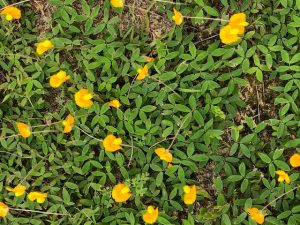
Perennial peanut is a drought-resistant, salt-tolerant, erosion-managing groundcover. Photo credit: Carrie Stevenson, UF IFAS Extension
Its bright yellow blossoms are delicate and almost orchid-like in shape, standing upright on a thin stem. As mentioned earlier, the flower is also edible and has a very light peanut flavor. The foliage, a deep green with compound leaves, lies close to the ground. Its spreading rhizomes serve as an excellent erosion control method, holding even easily washed out sandy soils in place.
Like its more well-known cousin, the perennial peanut is a legume, which means it can “fix” atmospheric nitrogen, transforming it into a form the plant can use. For a homeowner, this means you do not need to add nitrogen fertilizer. If phosphorus levels are naturally high enough in the soil (as is often the case in south Florida), only small amounts potassium-magnesium sulfate may be needed.
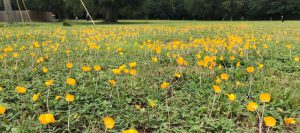
Perennial peanut is a great choice in open areas. Photo credit: Carrie Stevenson, UF IFAS Extension
Perennial peanut is best utilized in open spaces without high foot traffic. If you’d like to see it, come out to the Escambia Extension office; there’s a large swath of it between our main building and the demonstration garden near the walking path. If you are interested in planting or maintaining it, check out these documents from UF IFAS Extension or watch this informative video from a colleague!

by Carrie Stevenson | Jun 4, 2020

The lineup of 2020 tropical storm names. Tropical storm “Cristobal” is currently headed towards the northern Gulf of Mexico. Photo credit: The Weather Channel
This past March, many people spoke about sensing a sort of free-floating anxiety, waiting for potential disaster to land at their doorstep. The unknowns we faced as COVID-19 cases increased in the United States were not quite like anything we’d previously experienced, although it felt comparable to knowing a hurricane was about to make landfall. After this virus, perhaps, a hurricane seems like a relief—at least we know what to expect and approximately where the most damage will occur. However, big tropical storms carry with them their own set of unpredictable factors like direction and strength at landfall. But the storm-hardiness of our homes, our tree choices, smart evacuation plans—these we can control. Well-thought out precautions can make the difference between getting right back on your feet after a storm and losing almost everything.

Aluminum shutters are one of the many preventative measures Florida homeowners can include in their hurricane preparedness.
Photo: Carrie Stevenson, UF IFAS Extension
No matter how well you have planned for a hurricane, unexpected issues always come up. However, being ready can cut down on the fear and worry.
A few of those preparedness factors include:
* An evacuation plan
* A hurricane kit
* Home wind mitigation techniques
* Tree evaluation
* Wind/flood insurance
I will discuss each of these topics in depth over the next few weeks. Particularly if you are new to the area or never experienced a hurricane, be sure to review good readiness websites, check out these apps, and see which tips might be the most useful to you and your family as we enter the already-active 2020 hurricane season.
















